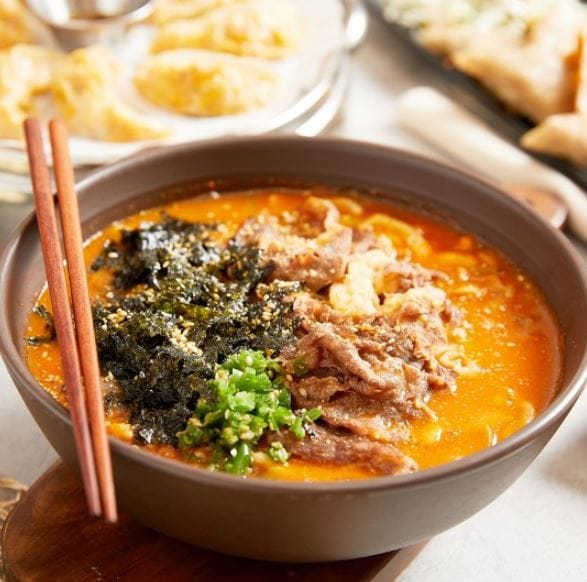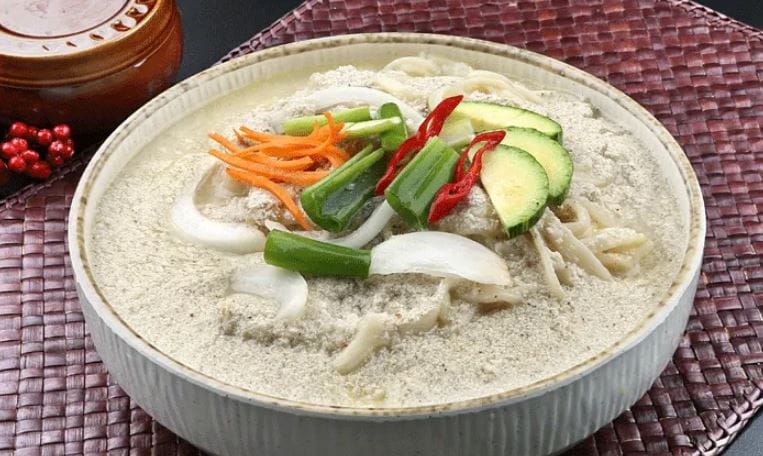Wait... how do I eat it?
FOOD TOUR episode#03

Kalguksu, as its name suggests, is a combination of "kal" (knife) and "guksu" (noodle), referring to noodles that are made by cutting dough with a knife. It does not imply that one eats the noodles with a knife instead of chopsticks. Instead, the term describes the method of preparing the noodles by rolling out the dough and then cutting it into strips. So when you see "knife noodle" on a menu in Korea, there's no need to be confused!😅


Kalguksu is a traditional dish with a rich history in Korea. For many older generations, it has been a vital source of sustenance. During the Japanese colonial period, Korea's food culture was severely disrupted, but after the liberation and through the Korean War, wheat flour became more common in the cuisine. After the war, as Korea was devastated and food was scarce, the country received flour aid from the United States, allowing for the affordable production of delicious noodles.
A 1931 article in a well-known newspaper stated, “Kalguksu can also be made with barley flour instead of wheat flour.” This highlights that barley was commonly used for making kalguksu in the past. As wheat flour became more accessible, noodles became a staple in Korean diets, and Koreans are now recognized as one of the highest consumers of noodles in the world.
In recent years, the popularity of Pyeongyang-style cold noodles has sparked significant interest in noodles. Additionally, instant noodles gained attention following director Bong Joon-ho’s Oscar win, leading many to try making them at home.
China has heavily influenced noodles in Korea. Wheat flour and noodle-making techniques were believed to have been introduced during the Han dynasty. Initially, noodles were considered a luxury food, handmade from scratch. Over time, however, they evolved into an essential staple in Korean cuisine.
Korean noodle-making methods can be broadly divided into two categories: the extruded style used for cold noodles and the cutting method used for kalguksu. Kalguksu is particularly popular because it can be easily prepared at home. The noodles can be made from either buckwheat or wheat flour, and different regions use various ingredients and seasonings.
The earliest written reference to kalguksu is in the "Eumsik Dimibang," which dates back to around 1670. In it, a recipe mixing buckwheat and wheat flour is described. Today, diverse types of broth and ingredients are utilized in various kalguksu restaurants across Korea.
One of the most popular locations for kalguksu is the kalguksu alley in Namdaemun Market, which has been popular since the 1950s. Kalguksu is appreciated for its rich broth at a low price, making it especially popular among middle-aged customers. Over the years, restaurants specializing in kalguksu have emerged, each offering unique flavors based on different stocks and ingredients.







Anchovy Kalguksu, Clam Kalguksu, and Chicken Kalguksu on the first row; Cow bone Broth Kalguksu and Spicy Kalguksu on the second row; Perilla Seed Kalguksu and Red Bean Kalguksu on the third row
Here are a few notable types of kalguksu:
- Anchovy Kalguksu: The basic kalguksu, made with anchovy broth. It has a clean taste and is usually the most affordable option. A tasty side of kimchi is essential, as it pairs perfectly with kalguksu.
- Clam Kalguksu: While seafood kalguksu exists, clam kalguksu is particularly popular. It's best enjoyed in a large bowl shared among several people.
- Chicken Kalguksu: This is made with chicken bones and meat, resulting in a deliciously light and savory broth.
- Cow bone Broth Kalguksu: Made with beef bones, it's incredibly comforting during winter, warming you up on cold days. However, be mindful if you're watching your calories!
- Spicy Kalguksu: This version includes hot pepper and soybean paste for a hearty, spicy broth. It originates from the Gangwon province and has gained national popularity for its bold flavor.
- Perilla Seed Kalguksu: Made with perilla seeds, this variant has a mild and nutty flavor without any spiciness.
- Red Bean Kalguksu: Though not widely popular, this type of kalguksu made from red beans is favored by some seniors.
Kalguksu has evolved over centuries, embodying Korea's culinary heritage. It remains a significant part of Korean cuisine today. When visiting Korea, try kalguksu for an authentic taste of traditional Korean flavors!👍👍✔️




Comments ()